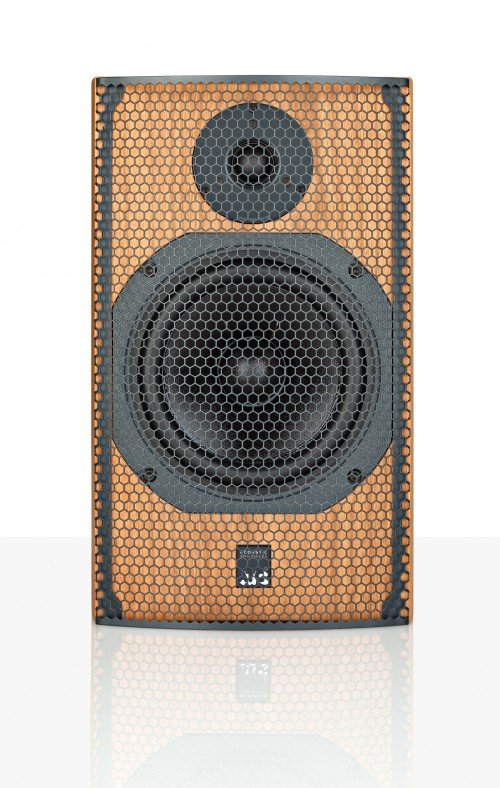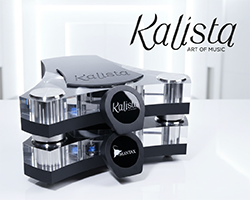The SCM (Studio Control Monitor) range of loudspeakers and undergone a redesign and revamp of late, most  noticeable is the new curved cabinets functionally superior and visually more appealing than the classic box type design.
noticeable is the new curved cabinets functionally superior and visually more appealing than the classic box type design.
The cabinets are constructed from multiple laminated layers of medium density fibreboard and all planes are of the same thickness and strengthened with horizontal bracing increasing rigidity and damping. Finish in a real wood cherry veneer or black the SCM11’s looked fantastic on inspection after arrival (review samples were in cherry).
The next significant upgrade to the speakers was a new tweeter. The SH25-76 tweeter is the brainchild of ATC and is constructed in house, comprising of 8 parts including a doped polyester diaphragm and suspension system and a neodymium motor assembly keeping the tweeter small and of low mass for close positioning with the mid bass driver for critical integration of frequencies, although ATC do produce drivers for other companies (I recall the midrange driver on a set of Ruark Crusader III’s which my brother owned) the new tweeter is strictly off limits and only features in ATC’s range of loudspeakers.
All ATC drivers use their own specially formulated doping compound. Being of a low mass it allows the driver to remain fast and accurate as well as having high damping properties removing excess energy and controlling unwanted resonances. The mid bass driver is made from acrylic and soaked in the formula leaving a slightly sticky to the touch feel. I voiced concerns at the time that after a period of time surely they would gather dust but was soon reassured by ATC’s PR guy Keith Haddock that he has multiple pairs in what he calls his ‘shack’ his man cave out in the garden and although he does admit to dragging in dirt and dust frequently he firmly stated that the drivers haven’t collected any particles and look as new still. Inside the packaging is two drawstring cotton bags, personally I’d be inclined to place them over the speakers when not in use for protection.
With the new tweeters in place this was of course a natural event that the crossovers would be reworked. The components used are high power rated wire wound resistors, audio grade metalised polypropylene film capacitors and air cored inductors.
THE SOUND
Interested to hear what the new tweeter was going to offer the overall performance of the SCM11, I hooked them up to my Jeff Rowland integrated. The speakers although not high current demanding require an amplifier with some good power as they are not very sensitive at 84db, so ATC recommend an amplifier of at least 75wpc, the Rowland can output twice that into class A/B.
During playback of some very minimalist Acoustic work it was really very obvious that the SCM11’s have a quick transient response. When listening out for the striking of piano notes, drum beats or plucked strings the ATC’s quick nature snaps into action with a controlled edge peaks with the first portion of a note and lays out the follow through with fantastic timing. Most definitely attributed to the new tweeter the SCM11’s remain accurate without ever over stepping the mark into an analytical type sound.
I recall when I had many sets of studio/active monitors and although not really for the home listener I generally enjoyed the revealing nature of many of the types I had, although some were dreadful and not suitable for playback just monitoring. It’s fine to have a monitoring speaker for mixing and hearing deep into the track but for playback really not so tasteful and a lot of the time bluntly aggressive. The SCM11 are for me what I would have dreamed to have in a compact style speaker back then for playback of the completed music. They are magically insightful and transparent, lack colour and attenuation and are just so damn musical. I would never say that they are designed for the ‘best of both worlds’ but my god don’t they excel in each environment.
Listening to some Porcupine Tree and Fink allowed me to assess some busier more demanding music, with large basslines, intricacies of multiple instruments playing at once and dynamic transients that only the most stable transducers can deal with I found the stability of the image to remain constant and focused. Confident and articulately astute the ATC SCM11 have one of the least confusing un-muddled sounds I’ve ever heard from a speaker in this price range – full stop.
The phrase ‘the whole enchilada’ applies well to the SCM11’s – meaning ‘to give their all’. The sound from these infinite baffled standmounts is non constrictive and effortless. The drivers feel as if they are giving their all at all times regardless of volume levels there’s an incredible openness and freedom to the sound produced. Late night listening at lower volume levels reveals every aspect of the music and all complexity of detail is apparent still, just as if they were being worked with higher watts.
The older ATC’s were of a presentation that at times took no prisoners when they were fed with less than high quality recordings. The latest incarnation are no bed and breakfast nor are they Guantanamo Bay! The new SCM11’s and they’re stellar new tweeter expose every detail in the music in the most convincingly enjoyable manner and reflect any choice of genre with an evenhanded experienced touch, the feeling when listening to the SCM11’s is one of mischievous maturity – I may be older now but I still feel like a teenager!
During playback of Derrin Nuendorf’s live album, at the beginning of Ghost Town I sat up in my seat and thought ‘what on earth is that cat up to now?’ I have a very curious black cat who loves getting into amplifier boxes, bags and cartons if she can and fall quite comfortably to sleep. I make a point of not leaving any boxes lying around open because of this. I looked left, looked right and then had a double take, I couldn’t see her in the room at all. I went into the bedroom and she was fast asleep and mischief free on the bed? So I went back to the listening room and started the track again…
‘What is that noise?!’ it sounded like something rustling somewhere. So I’m now searching for a possible rodent that may well have accompanied the cat on return from her last outing! Nothing! Once again I started the track and then my brain clicked, aha! It was only Derrin sat on his stool, shuffling about a little bit trying to get himself comfortable. His trousers were rustling and the sound was being picked up by the microphone.
This was the point where I really thought wow, this new ATC design tweeter is remarkable as I’ve never heard this before from my Accuton tweeter. The sound was so realistic I believed the noise was emanating from the physical room itself.
Bass notes from London Grammar’s ‘Hey Now’ are usually large, full, bold and deeply extended with the Ayons, using a standmount of course represents limitations of lower frequency responses. A friend commented that ‘Standmounts do tend to have that increased peak in the upper bass to give the impression of more bass and I think these seem typical of that’ I begged to differ and questioned what he was hearing.
To me the mid to bass integration of the SCM11 is fairly flat and utterly seamless and although I agree many standmounts will have an exaggerated upper bass I didn’t see it being predominant or even slightly recognised in a way with the ATC’s. I would say that they response is very linear and the bass characteristic reflects a punchyness and dynamic tendency of the driver. If this driver was in a larger cabinet its punch would be perceived with more weight and the cabinet would express an extension of the drivers natural agility but in the 11 litre cabinet of the SCM11 I was confident that what I was hearing wasn’t a crossover but an attribute of how controlled, punchy and dynamic the ATC mid bass driver can hold a honestly portrayed beat.
This left London Grammar’s track and bassline to reflect the positive impact and heft of the bass yet didn’t reflect its full presence as the note does is double drop into lower frequency ranges. The track is a great demo tune to test the bass note as on any good system/speaker combination the skin of the drum can clearly be heard when hit with the rubber ball, then the drop into lower bass will show any sharp roll off and steep angle of descent present by a poorly implemented cabinet or crossover.
The very bottom edge of the ATC’s frequency response is really rather nice, there seems to be a gentle roll off that allows for decay of the bass note yet is strict enough to allow the speaker to remain fast and immediate on cue for the next powerful note. It’s response in the lower end allows for a plentiful and most satisfying ability to conveying a completeness to the sound.
ATC’s midrange is famous for being coherently impressive and just like the previous version of the SCM11’s controls a female’s high octave and a male’s lower tone absolutely brilliantly. Jennifer Warnes, Eiana Krall and Loreena McKennit produced a mixture of hypnotising tones that just make the listener crave for more, lucid and powerful upper mid response is so controlled remaining utterly powerful yet never peaky. With male vocalists such as Damien Rice, Chris Jones and Micheal Buble a full range of tone is put so true and focused into the centre stage with the reverberance of extreme lower mids adding the feel to the vocal just like a super tweeter adds the openness and air to a top end, the extension of the midrange was so correct and organic.
The SCM11’s do come with metal grilles which have fairly open frames and wide spacing. ATC do state that the speakers are designed to be optimally used without them on but I listened to them on and off and to be honest left them on a great deal of the time, never feeling that they were hampering the sound. The grills are attached with buried magnets in the speaker’s cabinet but are not that strong.
To hear how emphatically exciting the SCM could be I played a lot of dance music one weekend evening when friends came over for a few drinks. There was no denying that the speakers are dynamically incredible with electronica and the already complex soundstage just explodes throughout the room, bass lines came thick and fast and kick drums really seemed to move substantial amounts of air….as well as the grills! After a period of loud volumes and stiff beats the grills would be slid down the speaker 7-8mm. Although most people wouldn’t use them I would and also pop the bags over them when not in use to preserve what is one of my favourite Standmounts I’ve had the pleasure of hearing.
CONCLUSION
You could argue that the ATC’s don’t have the luxury and flair of aesthetics as say a Sonus Faber but then it was Italian engineering that built the leaning tower of Pisa and British engineering that built Buckingham Palace and The Houses of Parliament.
The ATC’s are a solidly built real wood veneered ‘stylishly classic’ speaker which embodies a solid listen. Their strongly braced infinite baffle construction allows for their representation of the music to be truly outstanding, they give insight into the most intricate of tracks or can relaxingly and effortlessly flow with less busier material.
Although the previous model was thoroughly enjoyable they could sometimes bite back when fed with less than adequate recordings, as we say ‘rubbish in, rubbish out’. However now in their prime and more mature manner the ATC new in-house designed and built tweeter has the experience to tackle events with a second nature and never be phased or rocked of its confidence giving it the hallmark of a truly outstanding achievement by the company.
For the money and putting my experience and word on the line the ATC SCM11 are at the absolute top of their class and you really would have to spend much more to even be able to stand up confidently against these awesome little speakers let alone better them. If I had the room for another pair of speakers I would have a pair in a heartbeat.
Price at time of review – £1,200
Build Quality – 8.5/10
Sound Quality – 9.2/10
Value For Money – 9.3/10
Overall – 9/10
Recommended for being the most insightful, engrossing, fast, fun and accurate speaker to have ever graced its price range.
DanWorth
With an overall score exceeding 8.5 for the ATC SCM 11s from Dan, Hifi Pig scoring policy means we handed the speakers over to Dominic for his follow up views on these speakers.
Due to time constraints, I had only a short amount of time to evaluate the ATC SCM 11s, but even so they have left a lasting impression on me.
Dan has done a pretty comprehensive job of describing the construction and history of these speakers, so I see little point in repeating any of it, so I will crack on with giving you my own perceptions of this loudspeaker’s performance.
SOUND QUALITY
My review notes have words like “fast”, “agile”, “lithe” and many other similar descriptions to describe the SCM 11’s performance but that isn’t the whole story of course. It isn’t a relentless parade of spotlit details and raw dynamics, oh no, it can also do subtle and refined in spades , picking out the finest nuances and telling it like it is in a mellifluous flowing way that very few other speakers have mastered.
It is the bass performance of the SCM 11’s that Dan and I diverge over. I see it as an 11 litre cabinet housing a fine performing mid/bass and it is that same 11 litre cabinet size that determines it’s bass output. ATC’s own specifications state the frequency response to be 56Hz-22kHz and that pretty much bears out what I heard, in that the very bottom octave wasn’t being transduced in full. However, the roll off wasn’t a cliff edge sort of drop, it was well obfuscated with a gentle slope and it did bring some sonic benefits with it. What was lacking in the lowermost frequency was more than compensated by the sheer control and muscular bass power this speaker could produce, so it was always taut, coherent and informative like no other speaker I have heard.
London Grammar’s “If You Wait” album has organ in the mix and when the bass pedals are hit it regularly produces a “one note bass” reverberation that really does wrong foot most speakers, producing a booming effect in my listening room. With the SCM 11’s this did not happen at all, so where I would normally wince at this effect with other speakers, it was thrilling to play those notes cleanly and powerfully without any pain. I was starting to really like this bass. The same album has copious amounts of artificial ambience added to it so the album sounds like it was recorded in a large room, but the ATC’s managed to make it sound like a cathedral or aircraft hangar, it just seemed to go on and on to almost infinity, which was very pleasing.
I put some dance music into the CD player and that too was a prime example of just how controlled the bass is. Kick drum beats really did stop and start on the proverbial sixpence, mix in some heavy bass guitar and the SCM 11’s positively BATHED in it, add all the other instruments and vocals, but rather than collapse inwards and wilt like most other speakers do, they seemed to lap it up and shrug off the task, seemingly wanting more in defiance, they were truly unflappable. Dominic is impressed.
But not for long. Next I put in my favourite torture track from Porcupine Tree’s “Deadwing” album and the title track was a torture track in every sense of the word. The recording is raw and full of uncouth energy and that’s exactly what the SCM 11’s gave me, warts and all. I am though heartened by the knowledge that the previous incarnation of the SCM 11 would have MURDERED this particular track. My resident speakers are obviously a lot more forgiving it seems.
Another Porcupine Tree CD and this time it was “Metanoia” into the player. Track one of this CD has a burst of fast dynamics within the first minute of the track in the shape of a rapid quick succession drum roll which really does sneak up on you with instant explosive power, which vanishes equally as quickly. It has the sort of power that should be felt every bit as much as it’s heard and make no mistake, the ATC SCM 11’s did exactly that, so it felt like it penetrated right into my very core being. My wife came running into the room thinking a runaway truck had collided with the house. It was so good and satisfying, I played that short excerpt several times over. Funny lot, us reviewers.
On to some gentler music now and Fink’s “Sort of Revolution” went into the CD drawer. Fink on vocals and playing the acoustic guitar, a bass guitar and drum accompaniment sets the scene throughout the album. Regularly interspersed with both hard and gentle strikes to the Ride cymbal that produces a crisp “ting” and the ATC’s also reveal the resulting shimmer of the cymbal long after the strike in great detail and clarity, which has raised the bar considerably for one of my benchmark tests. Bass guitar and kick drum produce a pounding rhythmic beat that is weighty, propelling and perfectly timed, while the snare drum has that fast rise time explosive “crack” and the following drum shell sounds included too which I feel is essential for true hi-fi sound. Fink’s vocals are very difficult to reproduce and most speakers give an interpretation of his voice, not an entirely accurate rendition (Mark Knopler’s voice too for that matter) so the gravelly undertones are missing, although the ATC’s did a fine job and once more set a high precedent that other speakers ought to be matching, or at the very least, striving towards.
CONCLUSION
The ATC SCM 11’s are not perfect by any means – no speakers are, so it’s all down to compromises that we either can or can’t live with. I could easily live with the lithe dynamics, the outright faithful treble resolution, the midrange tonal accuracy of these speakers and oddly enough, I could easily live with that roll off in the lower bass registers as well, because the fast, taut, communicative and powerful bass that they do produce, more than compensates in that area. The most compelling reason of all is of course that £1,200 price tag and I would really struggle to name a single speaker that can get anywhere near such a stunning level of performance in that price range. As you read this review dear readers, I am polishing up my busking skills to be able to afford a pair for myself.
Build Quality: 8.5/10
Sound Quality: 9.3/10
Value For Money: 9.5/10
Overall: 9.1/10
Price at time of review – £1,200
Recommended for: Tonal accuracy, fast and lithe dynamics and taut powerful bass. At the price there are very few if any rivals.
Dominic Marsh
















































































































































































































You must be logged in to leave a reply.